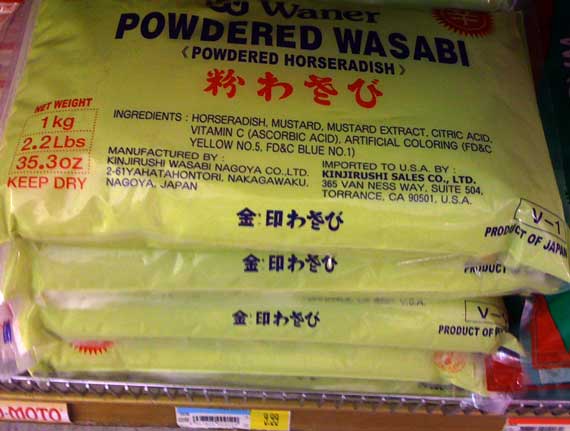
The ten-dollar deal! Note: contains no actual wasabi.
Seriously, this much wasabi powder must affect the global climate—and there were more piles of kilo bags, in various brands, right next to these!
Flowering update
Most of the dogwoods I’ve seen around the city are full open and brilliant, and many azaleas are nearly open; however, the white azaleas in our backyard are only about 20% open. Too overcast/rainy to photo today; maybe tomorrow.
5 April 2008 at 10:05 am
Pooh says:
I agree, that’s a lotta hotta!
My understanding was that wasabi was Japanese horseradish. Maybe adding the mustard (and the FDC yellow and blue) is what distinguishes it from good-ole American horseradish.
A digression on the subject of mustard. When Dave was young he used to confuse waitresses and waiters by asking for “cold mustard”. What he wanted was “regular” yellow mustard, and not the “hot mustard” that came with Chinese food.
You probably already know that mustard is yet another member of the Brassicacae family – the family of cabbage, kale, brussel sprouts, broccoli, cauliflower, etc.
5 April 2008 at 10:25 am
Sammy says:
Pooh, yeah, wasabi is often referred to as “Japanese horseradish,” but botanically, it’s something different. We’ve eaten real wasabi, ground before our eyes on a special sharkskin grater, at two different sushi restaurants, and the wasabi powder stuff (meaning the horseradish/mustard combo) is stronger, harsher, and more biting. Real wasabi is still hot, but more complex and subtle. Check the link above, or this one JCB found, for more info….
6 April 2008 at 11:25 am
Pooh says:
Hmm, so horseradish, wasabi and mustard are all parts of the Cruciferacea/Brassicacea family. Yesterday’s comment was made w/o reading the facts entry, obviously. As my dad says, “Why let the facts get in the way of a good argument.”